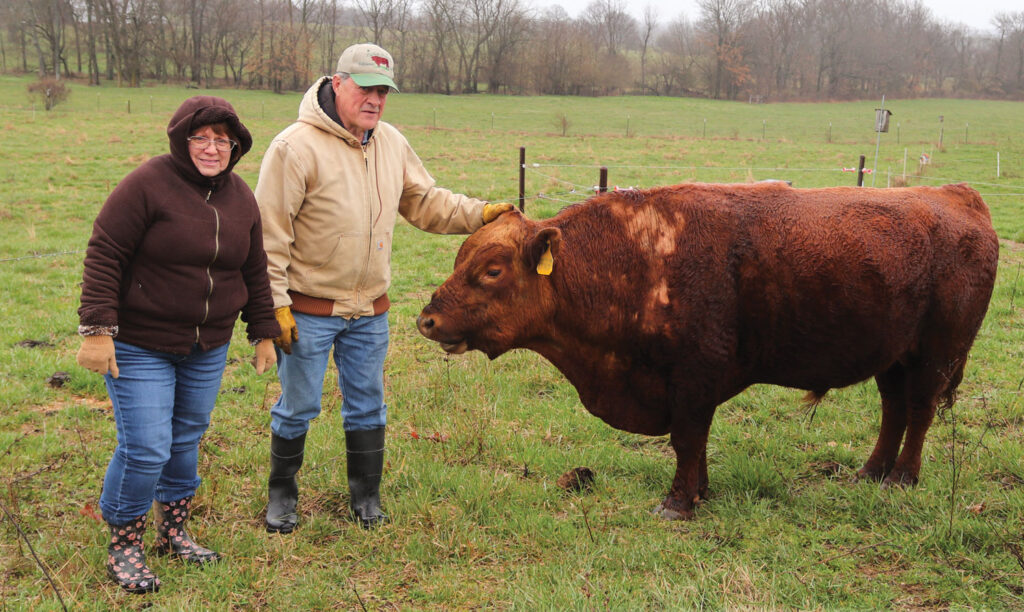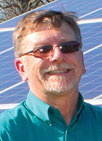
Brian and Kim Zahn offer customers products raised in an natural and sustainable manner
ELKLAND, MO. – Growing up, Brian Zahn wanted to be a farmer. His grandfather and uncle farmed in Northern Missouri, and Brian loved visiting them.
Brian enrolled in every ag class offered at his high school, but his dad convinced him to change his class load. Brian’s love for agriculture, however, continued.
Brian gardened for many years on a small property near Brighton while working in the Springfield School District, teaching German for eight years before moving into the IT department. When retirement approached, Brain thought it was time to become a farmer.
“We started looking at properties when we got married seven years ago. It was either really good land and really bad houses, or really good houses and really bad land for farming, then we found this place,” Brian said of their farm near Elkland, Mo. “(Kim) came into it with a little trepidation, being a city girl, but she has adapted well and does so much here.”
They started with 11 acres and bought 30 more acres about a year and a half ago.
Interior fencing for a grazing system on the 30 acres is still under development and will become the primary location for the couple’s South Poll herd.
“I did a lot of research,” Brian said of his South Poll cattle. “I didn’t want big, monster cows. I didn’t want horned or aggressive cattle.”
A grazing school led by Greg Judy showed him the gentle nature of the breed.
“We walked out there and walked up to a couple of bulls,” Brian recalled. “They looked up at us and then kept grazing. I thought this was the breed for us.”
Grass and mineral blocks sustain the cattle herd, which are rotated daily through a management intensive grazing system. When the grass begins to grow in spring, the herd rotates two to three times a day.
“I want my pasture in a vegetative state, so it will grow back quickly,” Brian explained. “If you graze it down to the ground, it takes longer to regrow; then you start getting into trouble in the summer. I like to stockpile for the winter and feed no hay here. The property up the road is in rehab, so I had to feed hay. Right now, all of the cows are here. When I have to feed hay, I feed someone else’s hay because I want to get someone else’s nutrients on my land to feed the land.”
With the MIG program, cattle naturally fertilize the ground in concentrated areas. At the home farm, there has been no other fertilization. Through the grazing system, Brian and Kim have seen native forages grow well and soil quality improve. A soil test at the 30-acre property recommended lime, which was applied. Brian expects similar results when the herd is moved, and the MIG program can be fully implemented.
They currently have 16 head of cattle, with six calves on the way.
“South Polls are a smaller-framed animal, and I know processors can get more out of larger animals, but when you have a 1,500-pound cow compared to an 800- to 1,000-pound cow, I can get three to their two per acre. I get more calves a year from an acre than they do, and my calves grow faster on just grass. Missouri has the largest number of South Poll farms in the U.S., so they are very popular in the state.
The preferred breeding method is natural cover and the implementation of an AI program is planned for the future as they retain heifers from their current herd sire.
“I’m very much into line breeding to concentrate the good traits,” Brian said. “You have to cull pretty heavy with that, but I’ve seen the benefits of it in several ranches, so that’s where I’m headed.”
Brian and Kim try to calve in early spring to avoid winter weather extremes.
“I’m not in the commercial market, so I don’t need calves twice a year,” Brian said. “Generally, we calve in mid-April through the end of May.”
He added that cattle are putting on weight in the spring of the year, which allows the females to cycle quicker and rebreed.

The Zahns sell two to four head annually through their beef sales, offering wholes, halves and individual cuts, with most of their sales being cuts. Calves going to beef sales are processed at about 2 years old and about 800 to 900 pounds.
“It takes longer, but I think you have healthier beef and healthier fats,” Brian said, adding that culled females can also go into beef sales, depending on the condition.
They have also sold a couple of South Poll bulls and females to fellow cattle producers.
“We can’t keep up with the demand,” Brian said. “Seedstock production was what I want to do.”
While they take an all-natural approach to livestock production, cattle do receive a blackleg vaccination annually, and ill animals are treated with antibiotics. Those animals are not, however, used for meat sales.
“If it’s a heifer, I’ll keep her to breed her,” Brian said. “That antibiotic isn’t going to pass on.”
Typically 120 to 150 laying hens spend the winter months in hoop houses, and fertilize the soil inside the structures, then go out on pasture in a mobile coop Brian constructed in warmer weather. The layers follow the cows through the rotation, allowing the pastured birds to spread the manure, find fly larvae and other bugs, and add fertilizer to the fields.
Kim and Brian also raise about 50 Cornish-cross meat birds a year in portable chicken tractors that are moved daily. Broilers come to the farm as chicks and are ready for harvest at 8 to 10 weeks, sometimes 12. After processing, the birds weigh about 5 to 7.5 pounds.
The pigs were the final addition to the farm, and not a part of the original farm plan.
“Three years ago, we had a friend who had to move and he had a boar and a sow, and some piglets,” Brian said. “For two months, they were here and as a thank you, he left two piglets.”
They have between 20 and 40 pigs each year, most of which are sold as feeder pigs, but they also sell pork as halves, wholes and in cuts, and are offered a hog growing ration from Crescent Feed. Pigs are processed at 250 to 300 pounds.
“My goal is to have pastured pigs,” Brian said, adding the pigs are housed in a large pen area. “Now that the grass is coming on, I am going to let them out into an area; I just don’t have the availability of my pasture to let them out right now. I want to get them trained to electric wire because I have a lot of woods at the other farm, and there are a lot of acorns there in the fall.”
Pigs and chickens also serve as “recyclers” for unsold produce and the remains from processed chickens.
In addition to their livestock operation, the couple maintains an orchard, and grows blackberries, blueberries, other produce and Shiitake mushrooms.
Zahn Farms offer no claims of being organic but raises all animals and plants as naturally as possible, with no chemical fertilizers, pesticides or herbicides.
“We want to be as honest as possible and to provide safe, sustainable foods,” Brian said.
The couple offers their products at farmers markets in Marshfield and Lebanon.
“We eat what we grow, and we grow what we eat,” Kim said. “We grow what we need first and sell the rest.”
Brian’s father, who was an avid gardener, may have persuaded him to take other classes in high school, but he never discouraged his farming dream.
“It was a rough time for farmers back then,” Brian said. He saw that a lot of family farms were starting to go under, and it was difficult to make a living farming. He wanted me to have something to fall back on if I went into farming anyway so I could still make a living. He never said, ‘I don’t want you to be a farmer.’ He was glad I finally found my farm.”







